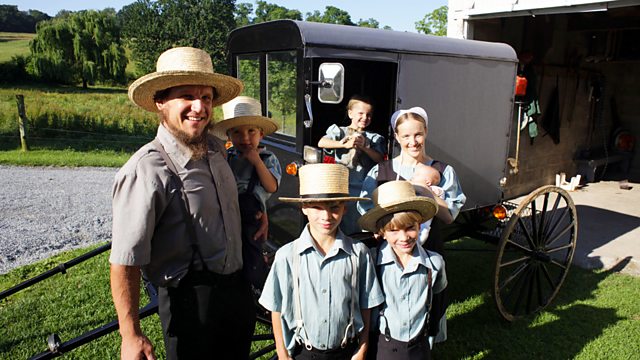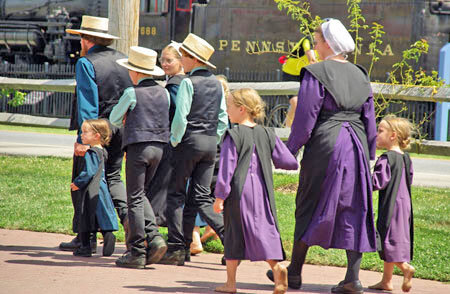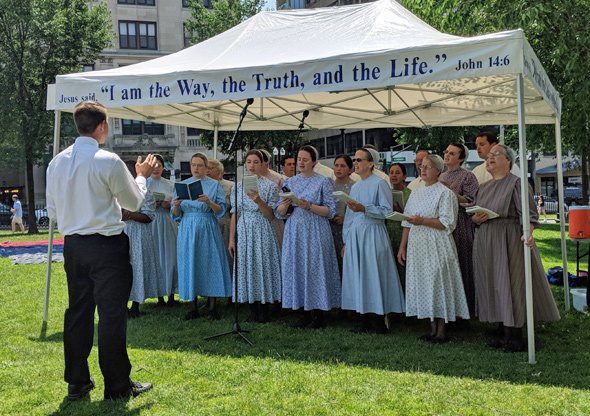While Mennonites and the Amish come from the same Anabaptist roots that began in the 16th Century, the Amish became a separate group from Mennonites.
In 1693, Swiss Anabaptist leader Jacob Ammann did not believe that banning and shunning was being practiced well enough. He felt the current church was not strict enough and he separated to create the Amish.
The groups agree on many beliefs (such as pacifism and adult baptism), but the Amish follow a stricter doctrine. Read and learn more about this two groups.
Who are the Amish?

The Amish are descendants of Swiss Anabaptists who migrated to North America in the early 17th century to escape religious persecution in Europe. They settled primarily in Pennsylvania, and their community has since spread to other parts of the United States and Canada. The name “Amish” comes from Jakob Ammann, a Swiss bishop who played a role in the formation of the Amish church.
They believe in adult baptism, which is why they are often referred to as Anabaptists. Their faith places a strong emphasis on living a life separate from the world’s temptations. They are known for simple living, plain dress and Christian pacifism.
They reject many modern conveniences, such as electricity, automobiles, and telephones, as they view these as distractions from their religious and community-focused lives. Instead, they rely on horse-drawn buggies, gas lamps, and other non-electric technologies.
The Amish value rural life and community is at the heart of Amish life. They live in close-knit communities, often referred to as districts or settlements, where they support one another in various aspects of life. Families are large, and children are considered a blessing from God. They have a strong work ethic and involve all family members in many farm and household tasks.

The Amish have distinctive clothing styles that emphasize modesty and uniformity. Men typically wear plain dark-colored suits, while women wear modest dresses with bonnets or prayer caps. These dress codes vary slightly among different Amish groups.
Agriculture is central to the Amish way of life. They are known for their farming skills, particularly in dairy production and crop farming. Many Amish communities also engage in skilled craftsmanship, producing high-quality furniture, quilts, and other handmade goods. These products are often sold to the broader community.
Amish children attend one-room schoolhouses run by their own community members. Formal education only goes up to the eighth grade, after which children are expected to contribute to the family’s livelihood. The main language spoken among the Amish is a dialect of German known as Pennsylvania Dutch or Pennsylvania German.
In Amish culture there is something called “Rumspringa,” which is a period during adolescence when Amish youth are allowed to experience the outside world and make a choice about whether to commit to the Amish way of life or leave the community. While some choose to leave, many decide to remain within the Amish faith.
Amish religious services are held in homes rather than in churches, and they are conducted in a simple manner, with singing, prayer, and Scripture readings. Worship services are usually conducted in Pennsylvania Dutch or High German.
Beliefs and practices
- Persons are baptized when they are admitted to formal membership in the church, about the age of 17 to 20 years.
- The Amish are known for their plain attire. Men wear solid colored shirts, broad-brimmed hats, and suits that signify similarity amongst one another.
- Women have similar guidelines on how to dress, which are also expressed in the Ordnung, the Amish version of legislation. Old Order Amish women and girls wear bonnets, long full dresses with capes over the shoulders, shawls, and black shoes and stockings; their capes and aprons are fastened with straight pins or snaps.
- Amish women never cut their hair, which is worn in a bun and are not allowed to wear jewelry, such as wedding rings, as it is seen as drawing attention to the body which can induce pride in the individual
- Different Prayer kapps and bonnets are worn by the women. The color of the bonnet signifies whether a woman is single or married. Single women wear black bonnets and married women wear white.
- Amish men grow beards to symbolize manhood and marital status, as well as to promote humility. They are forbidden to grow mustaches because mustaches are seen by the Amish as being affiliated with the military, which they are strongly opposed to, due to their pacifist beliefs.
- All clothing is sewn by hand, but the way to fasten the garment widely depends on whether the Amish person is a part of the New Order or Old Order Amish.
- The Amish accept the photographing of their way of life, but they forbid photos of themselves, believing such things are graven images in violation of the Second Commandment.
Who are the Mennonites?

Mennonites trace their roots back to the 16th-century Reformation era in Europe, particularly in the region of present-day Germany and the Netherlands. They emerged as part of the broader Anabaptist movement, which rejected infant baptism in favor of adult baptism and advocated for the separation of church and state.
It was Menno Simons of Friesland (1496-1561), a Dutch priest who consolidated and shaped Mennonite theology and practice.
Mennonites are not a monolithic group, and there is diversity among them. Over the centuries, various Mennonite communities have formed with differing practices, interpretations of theology, and levels of engagement with the modern world. Some Mennonite groups are more conservative, while others are more liberal and open to contemporary culture and technology.

Mennonite worship services are generally characterized by simplicity and a focus on community participation. Services often include a cappella singing of hymns, prayer, Scripture readings, and sermon.
Mennonites have a strong tradition of social justice activism and service. They are often involved in relief and development work both domestically and internationally. Organizations like Mennonite Central Committee (MCC) are known for their humanitarian efforts, disaster relief, and community development projects.
Mennonites generally value education and literacy. Many Mennonite communities operate their own schools, including elementary, secondary, and higher education institutions. While English is commonly spoken, especially in North America, some Mennonite communities maintain traditional languages like Low German or Pennsylvania Dutch.
Similar to the Amish, Mennonite clothing can be different depending on the specific community and level of conservatism. In more conservative groups, dress tends to be plain and modest, while in more liberal groups, Mennonites may dress in contemporary clothing.
Mennonites are involved in various economic activities, including agriculture, manufacturing, and business. Like the Amish, they often emphasize hard work, entrepreneurship, and community-based economic support.
Mennonites are found in many countries of the world but are concentrated most heavily in the United States and Canada. They have a strong tradition of missions and outreach, which has contributed to their global presence.
In the modern era, many Mennonite communities have faced challenges related to adapting to changing societal norms, technology, and globalization. Some have embraced modernity to a greater extent, while others have maintained their traditional way of life.
Beliefs and practices
- The largest assembly is the Mennonite Church USA Assembly, which meets on odd years. As a rule, Mennonites are not governed by a hierarchical structure, but there is a give-and-take among local churches and the 22 regional conferences.
- Mennonites church places emphasis on peacemaking, service to others, and living a holy, Christ-centered life.
- Mennonites are strong proponents of pacifism and nonresistance. They believe in following Jesus’ teachings of loving one’s enemies and refuse to participate in warfare or violence.
- Mennonites practice believer’s baptism, where individuals are baptized as adults after making a personal confession of faith.
- They have no church rules, but they rely solely on the Bible as their guide. They insist on strict separation from all other forms of worship and dress in conservative plain garb that preserves 18th century Mennonite details.
- Mennonites value community life and simplicity. They seek to live modestly, avoid materialism, and emphasize sharing and mutual support within their communities.
- Mennonites believe in the Trinity as “three aspects of the Divine, all in one”: Father, Son, and Holy Spirit.
- There is no formal liturgy; services consist of singing, scripture reading, prayer and a sermon. Some churches prefer hymns and choirs; others make use of contemporary Christian music with electronic instruments.
- Some Mennonite groups interpret the Bible quite literally, while others use a more nuanced hermeneutical approach.
Amish vs Mennonite: Key Differences
| Elements of Comparison | Amish | Mennonite |
|---|---|---|
| Followers | Anabaptists | Anabaptists |
| Founder | Jakob Ammann | Frisian Menno Simons |
| Type of Attire | Plain Traditional Clothes. | Normal Similar to Modern Look. |
| Mode Of Transportation | Scooters and Buggies i.e. a horse-drawn vehicle. | Modern Automobiles i.e. cars, buses, trains, etc. |
| Language At Church Services | German or the regular dialect of German or Pennsylvania Dutch. | English. |
| Use of Technology | Amish prohibit the use of modern technology in their life. | Mennonites moderately use modern technology in day-to-day life. |
| Living | Simple and in groups i.e. close-knit communities, not like to a part of the other separate communities. | Simple and they live as a part of the normal population. Not in separate communities. |
| Followers of | Amish strictly follows the non-resistance. A person who doesn’t follow church rules will be excommunicated. | Mennonites follow non-violence. |
| Hold Church Services | Privately at home. | Always at Church. |
| Dressing | 1) Women wear solid-color dresses. 2) Men have full beards | 1) Women wear flowered prints or plaid fabric. 2) Men don’t have a full beard. |